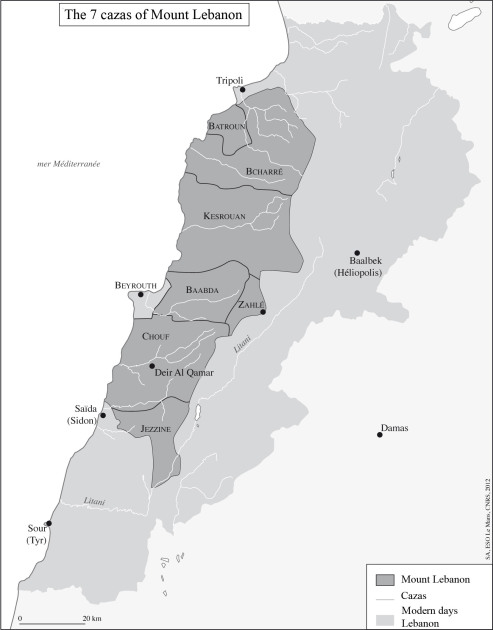The Keserwan Uprising (1858-1860)
Shekib Effendi gone, the fault lines in the system came into light. The Sheikhs – be they Druze or Christian – looked to recovering some of their lost authority. The British and the Russian, with the Crimean war (1853-1856) behind them, sought each in their own way to undermine the positions of the French who had done better out of the Règlement. Within the Christian Kaimakamate a power struggle had started for the highest position whilst peasant unrest rumbled especially against the Khazen[1]. It fed on the new ideas of « liberty »
and « equality »
that had inspired the European revolutions and that were passed on by Maronite monks. In that turmoil the clan chiefs tried to win over the peasants but they, meanwhile, had begun to organise in their Keserwan villages as early as February-March 1858. Each village elected a sheikh al shabab[2] to represent them and, on Christmas eve 1858, Tanios Chahine[3], self-styled Sheikh al shabab of Rayfoun was elected general representative for the whole of Keserwan.
Khorshid Pasha[4], wali of Sidon made no attempt to calm the situation and would be accused of having goaded the parties against each other before being cleared in court. Patriarch Boulos Massad[5] sought in vain to find a modus vivendi acceptable to the two parties. The Khazens refused any form of compromise. They were forced out by the peasants who confiscated their land and made it available to all. The family dispersed seeking refuge in Byblos, in the Matn and in Beirut, living in poverty for three years. Chahine, seen as a liberator, set up a style of government hitherto unknown in Keserwan. He was supported by a council made up with wakils from the villages. The council dispensed justice, enforced law and order and allocated the land. Decisions were taken « by virtue of the power of the people ... by virtue of the power of the government »
. This “republican” spirit disquieted the Southern district's authorities.
Intent on preserving traditional social structures, alarmed by the European – notably French – support going to the Christians, prompted by their uqqals[6], and goaded on by Damascus Sheikh Abdallah al-Halabi[7]'s fatwa according to which the « Christians could not be treated as equal to the Muslims »
and were fair game, the Druze started a war aimed at expanding their authority. They were supported by Ottoman troops and by the Sunni, notably in coastal towns and by the Shia, according to region. Everywhere, they had the upper hand: in the Chouf, the Bekaa and the Wadi al-Taym. The extent of the massacres (20000 killed, 100000 refugees) the importance of the destruction, the Ottoman authorities' failure to redress the situation and the fear of troubles spreading to other regions of Asia lead the European Powers to intervene militarily. On 16 August 1860, a French task force was dispatched with the mission to help the Ottomans restore order. Ships from the French and British navies patrolled the coast. In Damascus, Muslim dignitaries such as Abdel Kader[8] personally got involved to protect the Christians. An international commission was created to investigate the causes of the massacres, recompense the victims and establish a political regime liable to appease the region.
After negotiations stretching over six months, the Powers' representatives came to an agreement on a conflict resolution project. The European ambassadors and the Porte ratified the text. Under this Règlement organique (or settlement), a new regime, the mutasarrifiyya[9] was to run Mount Lebanon – and did so for half a century, from 1861 to 1915. It afforded relative peace and reasonable prosperity. Jamal Pasha[10] was to abrogate it in 1915 during WWI. Yet this regime allowed for the institutional transition that followed the war's upheavals and would serve as foundation on which to establish the Lebanese Republic.







